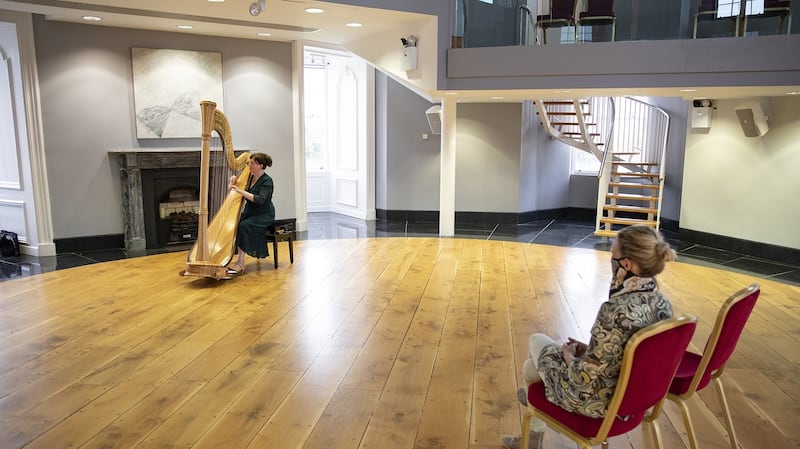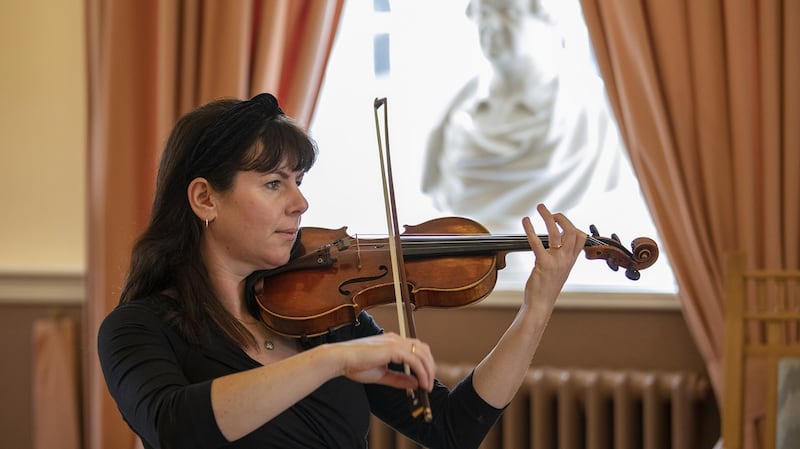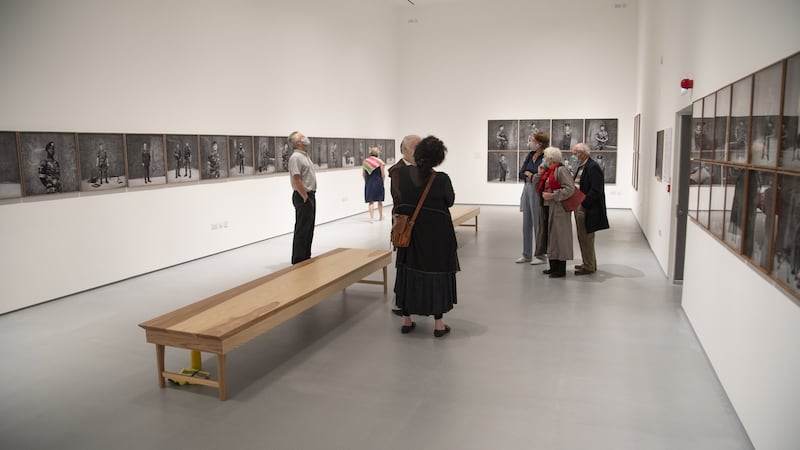On Solar Bones’ opening night at Kilkenny’s Watergate Theatre – one of only a handful of cautious, live performances these days – actor Stanley Townsend came back onstage after the standing ovation. Acknowledging the sparsely-spaced audience’s reaction, he put two fists up in the air, a gesture of triumph and joy and hope.
It was emblematic of the entire Kilkenny Arts Festival X undertaking. After initially cancelling the city’s annual multi-arts festival because of Covid-19, festival director Olga Barry and her team reconfigured some elements of their plans into an X version online including daily Secret Garden music and Hubert Butler lectures, but also with live elements of music, dance, theatre and exhibitions.
The festival’s co-production with Rough Magic of a stage version of Mike McCormack’s bold and brilliant novel, in association with the Watergate, managed to buck the odds and make live, indoor theatre.
Over five months after live performance was stopped in its tracks, the experience is almost surreal – feeling ritualistic and illicit. A drug analogy is partially apt: this commodity is in short supply, delivered with discretion but on the other hand it also feels careful and safe.
The audience gathers outside next to the theatre in an open space with tables (an unused site converted for the Covid era). You mask up, have a temperature check and are individually – escorted without stopping or touching but with charm – to your seat. Every second row is taped off, with another four seats blocked between seated individuals or couples. With scattered audience and doors open till just before curtain, the lights fade. It is goosebump inducing.

McCormack’s single sentence novel depicting the inner life of an engineer in Louisburg, Co Mayo is crafted for stage by writer Michael West and director Lynne Parker with profundity and nuance.
Stanley Townsend is an unexpected Marcus Conway, but very believable: reflective, fuming, tender, matter of fact. Prowling his kitchen he recollects a life both ordinary and extraordinary – the delicacy of a loving marriage, joy in his children, an ebbing father, professional integrity.
Zia Bergin-Holly’s set, a wooden house frame with clear plastic walls, is an engineering structure laid bare, but also subliminally echoes protective healthcare settings. This is not about the pandemic, yet below the surface the content seems apposite: her blood in Marcus’s daughter’s art installation, his care for his wife, seriously ill with another virus, cryptosporidium, the weighing of a life.
This epic encompassing domestic and small town life is illuminating in other ways. Tickets were €25 each, but because of social distancing – fewer than 50 allowed in the audience each night, 15 per cent of capacity – and increased costs (including longer rehearsal and production schedules, to avoid crossovers, the real cash cost of each ticket was likely six times that, Olga Barry reckons. And that’s aside from much benefit-in-kind from both Rough Magic and Watergate Theatre, and the cost of audience Covid compliance. While festival tickets are always subsidised by public investment via the Arts Council, the increased outlay and reduced box office return because of Covid for all live performance is stark.

Apparently the Child of Prague was out on Saturday night on foot of a yellow weather alert, and the rain held off for two Irish Chamber Orchestra concerts at Castle Yard, the first outing of an orchestra in front of an audience since March. The weekend also had more intimate musical performances, Encounters, where one ICO or Crash Ensemble musician performed for one person/family. For me, in a large upstairs open-windowed room in Rothe House, Crash’s Larissa O’Grady played Linda Buckley’s evocative Exploding Stars on violin with electronic backing, an intimate and moving experience of a big sound.
It was always going to be a significant year for Kilkenny, with Butler Gallery finally moving to its new location at Evans’ Home on John’s Quay after a €6 million redevelopment of the historic site. With 929 sq m (10,000 sq ft) and walled gardens, it’s not just a splendid (and free) gallery in a beautifully restored building, but a great addition to Kilkenny’s public amenities.
On the site of the 13th century St John’s Priory, Kilkenny County Council bought the former disused alms house for retired servants (1818-1968) from the Evans’ Trust in 1997, later investing €3 million in the project, along with €2 million from Department of Culture, Heritage and the Gaeltacht and Fáilte Ireland’s €1.135 million. McCullough Mulvin Architects’ restoration – occasional glass insets interrupting the original, pentimenti in each room revealing the layers of past lives within the walls – is striking and sensitive.
Director Anna O’Sullivan is delighted the new Butler finally has seven galleries for its collection, which has been long in storage, of 20th century Irish art including Paul Henry, Louis le Brocquy, Mainie Jellett and Mary Swanzy. It also has a wing for work by Kilkenny artists Tony and Jane O’Malley, education rooms, a lovely café extending into the gardens and a large double-height space for temporary exhibitions.

For the festival, as well as composer Sam Perkins’ mesmeric skateboarding film and score upstairs, Amelia Stein’s The Bloods is fitting for the location, once also an army site (1718-1818). A series of striking defence forces portraits from Kilkenny’s barracks, each large matt photograph of a soldier, proud against the textured greys of a handball alley, signals their diverse military roles including a nurse, machine gunner, hurler, chef, mechanic, barber and a sniper.
The gallery was two years in construction, but the project was 15 years’ work. Arguably a permanent home for the collection has been 77 years in the works since the Butler’s establishment in 1943.
A brave marker for continuity, the X version of the festival couldn’t dominate the sunny and buzzy city in the same way during Covid, but there were hints all over. Connected, Design and Crafts Council’s sculpture trail in the city, was a tangible sign of X. In some sculptures too were echoes of where we’re at, from Rachel Doolin’s delicate dandelion seed heads in The Fragility of Things in Castle Yard to Fiona Mulholland’s neon installation under the arches of the Tholsel, reading: “Are we there yet?”. Seems to say it all.



















